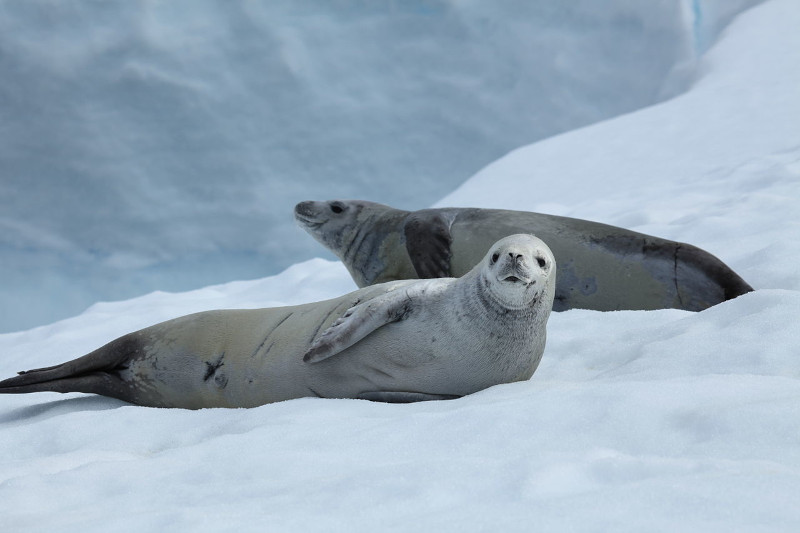
Crabeater Seal Facts
- This remarkable example of the adaptability of Nature most frequently goes by the distinctive common name of the Crabeater Seal. The amazing animal also has at least one other general title, though. That’s the informative term of krill-eater seal.
- Within the halls of academia, however, it’s perhaps better known by its technical moniker. That tag, though, is unfortunately one that’s difficult for the layperson to pronounce. That’s due to the fact that it has the official title Lobodon carcinophaga.
- The beatiful creature received that appellation due to the efforts of a duo of French researchers. Jacques Bernard Hombron and Honoré Jacquinot jointly accomplished the first recognition of it as a separate and distinct species. That occurred in 1842.
- This biological marvel stands out for several reasons. It’s the only member of its genus, and the most numerous of all varieties of seals. Numerical estimates vary greatly, but range from 7 – 75 million individuals. Despite its name, though, it doesn’t eal crabs.
- Thankfully, the population density of the amazing Crabeater Seal actually appears to be holding steady. Extremely unusual today, that pleasant state also seems to hold true in all parts of its range. The IUCN thus understandably lists it as Least Concern.
- This gorgeous mammal nonetheless still faces multiple potential threats to its continued existence as a species. In this, it’s facing the same issues as all forms of life on earth today. Most of those stem from the actions of man, including climate change.
Related Articles
Crabeater Seal Physical Description
The intriguing Crabeater Seal fully deserves the appreciation that the pinniped receives from those fortunate enough to encounter it. Unlike some of its relatives, however, it does so for more than just that visual appeal. That’s because it also boasts a respectable size.
Following a pattern in that regard prevalent among its many kindred, the animal displays a certain degree of the physiological characteristic of sexual dimorphism. In the case of this particular species, though, that trait manifests itself purely in terms of measurements.
More precisely, females of this work of Nature attain slightly greater sizes than their male counterparts. To the surprise of some people, that’s actually the case in the majority of currently known mammalian species. The difference remains extremely minor, however.
Collectively, mature adults reach an average total length of approximately 7.5 ft (2.3 m). In keeping with the trend of females being a tiny bit larger, this gender achieves a mean length roughly 2.4 in (6 cm) greater than the males. As stated, that’s a minor difference.
Weights differ between the sexes as well, though again to only a small degree. Males reach a mean body mass equaling about 440 lb (200 kg). Females, however, average roughly 474 lb (215 kg). But, exceptional examples of either sex sometimes reach 660 lb (300 kg).
Otherwise, the genders of the Crabeater Seal present the same appearance to the observer. Its fur generally presents shades of either silver or brown. Darker spots of either color usually develop around the flippers. These fade during the year, prior to moulting.
Compared to other members of its Family, this wonder of evolution possesses a relatively slender body shape. Both its snout and skull also follow this pattern. Its teeth are its most distinctive feature, though. Their tight fit allows the seal to sieve food from the water.
- Kingdom: Animalia
- Phylum: Chordata
- Class: Mammalia
- Order: Carnivora
- Family: Phocidae
- Genus: Lobodon
- Species: L. carcinophaga
Crabeater Seal Distribution, Habitat, and Ecology
The fascinating Crabeater Seal evolved as endemic to a comparatively broad expanse of the earth’s surface. Given its nature, the location of the zone of habitation isn’t going to surprise many people, however. The animal principally inhabits the area of Antarctica.
Since its territorial range is primarily circumpolar, it’s rarely seen outside of this region. Nevertheless, individuals and small groups do appear outside the area occasionally. It’s not known for certain, though, whether this occurs intentionally or accidentally.
With the rare exceptions noted above, this marvel of Nature typically displays decidedly strong and clear preferences regarding its choice of habitat. As a general principle, members of the species spend the entirety of the year on the pack ice found in the region.
This structure itself advances and retreats according to the seasons. Due to this location, this means that the majority of individuals spend most of their time near the continental shelf. The depth of the marine waters they inhabit rarely exceeds 1,969 ft (600 m).
The extraordinary Crabeater Seal further developed as a highly specialized carnivore. Approximately 90% of its diet therefore consists of Antarctic krill. The remainder of its prey includes other small creatures, such as various species of fish and small cephalopods.
This mammal also lives as the most gregarious of its relatives in the region. Whether on the ice or at sea, the young almost always stay in large groups. These sometimes number as many as 1,000 individuals. Adults, though, often live singly, or maybe 2 -3 together.
Despite its size, the species itself has its own share of predators. The young frequently fall prey to leopard seals. Mature adults, however, have fewer foes. Orcas are known to hunt them, though, as well as the young, indiscriminately. Larger sharks may do so as well.
Species Sharing Its Range
Adelie Penguin
Check out our other articles on 5 Marvelous Mediterranean Sea Species, Vietnamese Mossy Frog, Great Barrier Reef, Japanese Hare, Coral Honeysuckle, Scarce Swallowtail, Yellow-Bellied Sea Snake
